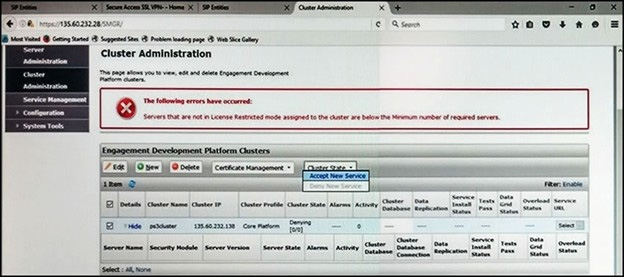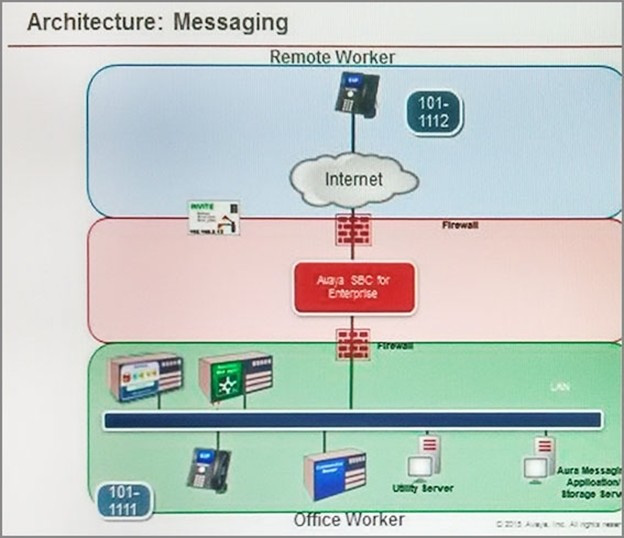72301X Online Practice Questions and Answers
In which way can you verify that STUN/TURN messages are being received from web browser at the Avaya Session Border Controller for Enterprise (SBCE)?
A. Enable traceFM with the STUN/TURN option enabled.
B. Enable traceSBC with the STUN/TURN option enabled.
C. Enable traceHTTP with the STUN/TURN option enabled.
D. Enable debug logging on SBCE and look in ipcs.log.
A customer reports that remote worker users cannot see their feature buttons. Their Avaya Session Border Controller for Enterprise (SBCE) was recently damaged and replaced due to a lightning strike. After doing some troubleshooting, support was able to see that PPM was misconfigured in the SBCE.
Which tool was used, and which symptoms were visible that pointed to this issue?
A. List trace; PPM requests were going to Avaya Aura Session Manager instead of the PPM server
B. traceSM; SIP requests were going to Avaya Aura Session Manager instead of SBCE
C. traceHTTP; all HTTP requests were going to SBCE instead of Avaya Aura Communication Manager
D. traceSBC with PPM debugging enabled; PPM requests were seen to be going to the Utility Server instead of Session Manager
Refer to the exhibit.

In the Cluster Administration screen of a PresenceServices cluster, when you try to change the cluster state to Accept New Service, you receive the error:
Servers that are not in License Restricted mode assigned to the cluster are below the Minimum number of required servers.
You check that a server has been administered under Breeze > Server Administration which shows green check under License Mode, and a System State of Denying.
Which action needs to be taken to solve this problem?
A. Edit the Cluster, access the Servers tab, and assign the server to the cluster; then set the cluster to Accept New Service.
B. Under Avaya Breeze > Server Administration, select the server and change the System State to Accept New Service, then return to the Cluster Administration screen and set the cluster to Accept New Service.
C. Obtain and install an Avaya BreezeTM license on webLM with more instances of Avaya BreezeTM nodes.
D. Edit the cluster to change the cluster profile from Core Platform to General Purpose.
In Avaya Aura 7 the Avaya Session Border Controller for Enterprise (SBCE) license is installed on an external WebLM server and the EMS points to the WebLM server using a URL. What is the correct syntax of that URL where 135.60.232.41 is the IP address of the WebLM server?
A. https://135.60.232.41:8443/WebLM/LicenseServer
B. https://135.60.232.41:8080/LicenseServer
C. https://135.60.232.41:52233/WebLM/LicenseServer
D. https://135.60.232.41/WebLM
Which statement about Avaya Tier 2/Business Partners is true?
A. They immediately escalate to Tier 3 as issue is encountered.
B. They describe the problem to Tier 3 in an escalation ticket and Tier 3 isolates and resolves the issue.
C. They isolate issue, resolve issue then escalate to Tier 3 for corrective action.
D. They isolate the issue, and if no root cause is found, escalate to Tier 3 to resolve the issue.
Refer to the exhibit.

Avaya Tier 3 support receives a case escalated by Tier 2 where the customer cannot receive incoming calls, but can make calls out successfully. The trace shows that the incoming calls arrive at the Avaya Session Border Controller for Enterprise (SBCE) but fail to get routed into the customer enterprise network.
Based on this information, what is and is not working?
A. The local area network, Avaya Aura Communication Manager, and Avaya Aura Session Manager are working. SBCE is partially working, but routing may be incorrect.
B. The local area network, Avaya Aura Communication Manager, and Avaya Aura Session Manager are working. The public network is not working.
C. The local area network, Avaya Aura Communication Manager, and Avaya Aura Session Manager are working. SBCE is not working.
D. The local area network and Avaya Aura Session Manager are working. Avaya Aura Communication Manager is not working.
How can you enable all levels of the log, including debug, to be dumped into the ps.log file?
A. Web browse to Avaya Aura System Manager (SMGR), navigate to Services>; Events > Logs > Log Settings, then enter PresenceServices into the Logger filed, and enter ALL into Log Level.
B. Use SSH to the PresenceServices Avaya BreezeTM node and execute thece dlogon PresenceServicescommand.
C. Use SSH to the PresenceServices Avaya BreezeTM node and execute theedp dlogon allcommand.
D. Use SSH to Avaya Aura System Manager (SMGR) and execute theedp dlogon allcommand.
Which three statements are true about Avaya Aura Messaging (AAM)? (Choose three.)
A. 20 Voice Ports are always reserved for retrieving messages.
B. AAM can run on Avaya-provided hardware that runs Linux and Avaya Aura System Platform, or VMware in a virtualized environment.
C. You can choose to use the Avaya Message Store or Microsoft Exchange Store.
D. AAM Multi-Server configuration separates Application Servers from Avaya Message Store.
E. Each message application server allows for up to 100 simultaneous SIP or H323 sessions, with 300 active ports permitted per Voice Mail Domain (VMD).
The WebRTC snap-in is showing a yellow caution icon under License Mode. What does this error mode indicate?
A. The license was installed incorrectly.
B. The license 30 day grace period has expired.
C. There is a license error but the snap-in continues to function.
D. The snap-in license has expired and is out of service.
Incoming SIP Trunking calls from Service Provider to Session Manager are failing because Avaya Session Border Controller for Enterprise (SBCE) is not sending a domain name in the TO, FROM and REQUEST headers. What needs to be changed in SBCE to make this happen?
A. In SBCE GUI, navigate to Global Profiles > Routing. Edit the Session Manager Routing Profile to link to a URI Group, which has the To, From and Request Headers and Replace Action set to Overwrite with domain name.
B. In SBCE GUI, navigate to Global Profiles > Server Configuration. Edit the Session Manager server entry to set "Overwrite Domain Name".
C. In SBCE GUI, navigate to Global Profiles > Topology Hiding. Edit the SessionManager_TH to change the To, From and Request Headers Replace Action, to Overwrite with domain name.
D. In SBCE GUI, navigate to Device Specific Settings > Endpoint Flows > Server Flows. Edit the Session Manager flow to change the End Point Policy Group to default-low.
Avaya currently uses the online tool called Avaya Diagnostic Methodology (ADM) for partners to raise trouble tickets and receive assistance, and expects customers/partners to have performed the following tasks before raising a trouble ticket.
1.
Clearly stated the problem.
2.
Detailed the findings.
3.
Clarified the problem.
When they receive the trouble ticket, what is the next step in the diagnostic methodology that Avaya Tier 3 support will perform?
A. Identify a patch to fix the problem.
B. Update the Knowledge Management database.
C. Implement a solution.
D. Determine the cause.
A customer called is stating they cannot place WebRTC calls. You discover that Avaya Breeze TTM has not been configured to allow Cross-origin Resource Sharing (CORS). How would you allow cross-origin resource sharing for all?
A. Use SSH to Avaya Breeze TM and edit the /etc/config.properties file.
B. Use Avaya Aura System Manager (SMGR) web GUI to access the Breeze>; Configuration > Attributes, then select the webRTC attributes and check the box Allow Cross-origin Resource Sharing.
C. Use Avaya Aura System Manager (SMGR) web GUI to access the Inventory>; Manage Elements. Edit the Avaya Breeze TM element, and check the box Allow Cross-origin Resource Sharing.
D. Use Avaya Aura System Manager (SMGR) web GUI to access Breeze>; Configuration > HTTP Security > HTTP CORS tab, the check the box Allow Cross-origin Resource Sharing for all.
In Avaya Aura 7, how are calls typically routed from Avaya Aura Communication Manager (CM) to Avaya Aura Messaging (AAM)?
A. Using an in-directly routed H.323 trunk group between CM and AAM via Session Manager
B. Using a direct H323 trunk group between CM and AAM.
C. Using SIP via Avaya Aura Session Manager (SM), AAM is built as a user with a Communication Profile and registry routing forwards the calls to AAM.
D. Using SIP via Avaya Aura Session Manager (SM), a dial pattern or regular expression forwards the call to AAM.
A Network Administrator of a company has been made aware of a problem with the telephone system, and contacts a few colleagues who have dealt with similar problems in the past. Which Discipline in 8D Methodology describes the action of the Network Administrator?
A. D4
B. D3
C. D2
D. D1
Which types of certificates can be verified from the Avaya Aura Application Enablement Services (AES) web console?
A. common a default Avaya SIP certificates
B. only Avaya server certificates
C. common and default Avaya server certificates
D. default certificates and Avaya server certificates
